 Go
to the Archive index
Go
to the Archive index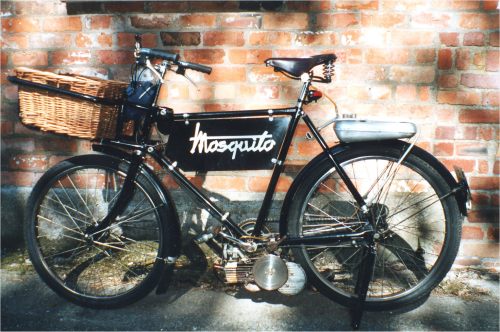
The 38cc Mosquito of the '50s
"Will this warm summer weather bring out more mosquitos in Britain? Unlikely, as they prefer warm, wet conditions..." (Dr Berens, School of Tropical Medicine, Liverpool University; Daily Telegraph, Saturday 23rd August 2003.) Well, only partly right: there is a surprising lack of Mosquitos in this country. But they certainly do not prefer wet weather!
Moto Garelli of Milan began production immediately after the war. Many thousands of the original (and in my view the purest) model were produced. It was described by a contemporary road tester as "an attractive little power unit that can be fitted in a few minutes to any standard bicycle". This first model has two fixing points: a clamp on the horizontal lower forks between the pedals and the rear wheels, and a flexible plate running upwards from the cylinder head fixed by a circular clamp to the tube running from the head stock to the pedals. The whole unit is suspended on two short hangers, with a lever enabling the driving roller to be moved onto or off the rear tyre. The whole unit weighs 21lbs. A separate, luggage rack petrol tank is fixed behind the saddle and above the rear wheel. A capacity of 38cc is achieved with a bore of 35mm and a stroke of 40mm.
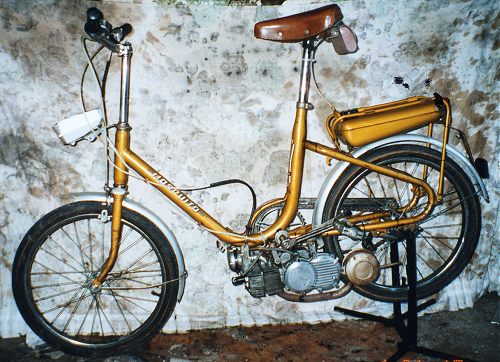
The 35.5cc Baby Mosquito of the '60s
This excellent little power unit runs happily up to 6,000 revs on a downhill slope, but produces its maximum power at 4,200rpm. Its horizontal cylinder is cast iron, while the domed cylinder head is of aluminium, containing a decompresser valve and a spark plug angled at approximately 20 degrees upwards from the horizontal. Drive is transmitted from the roller bearing crank shaft via a steel gear (attached to an external fly wheel) onto an intermediate fibre transfer gear, and then to the rear roller. This fibre gear deteriorates with age. I have three examples of this model, and in each have had to replace the fibre wheel with one remanufactured of bronze. The rear driving roller is approximately 3" in diameter, waisted, and fluted. To a smooth dry tyre transmission is good; to a treaded dry tyre, satisfactory; to any sort of tyre which is wet, very poor! It is possible in damp conditions to brake the bicycle to a standstill whilst keeping the engine running with a 100% slip against the tyre! These engines are rather sensitive to sparkplugs. The best is NGK B7 HS. (www.spark-plugs.co.uk are most helpful in supplying suitable plugs.) All Mosquitos, throughout their production run, used cast iron domed pistons.
Two of my original 38cc Mosquitos are mounted on bicycles, and used regularly. They will achieve speeds of about 20mph, and provided they are used in the dry need only modest LPA when faced with a hill!
One contemporary test put the fuel consumption at 240, and oil at 1,920 miles per gallon. This equates to a ratio of 8:1, richer even than that consumed by my 1947 Seagull outboard motor! No doubt that particular rider left a healthy trail of blue smoke behind him. Prices, in the late 40s, were about £25 per unit. It is interesting to note that a team of 8 heroes in the early 1950s rode an original Mosquito for 55 days and nights at Pau racing circuit, covering 25,000 miles at an average of 19 miles an hour. Perhaps backsides were more leathery in the 50s?
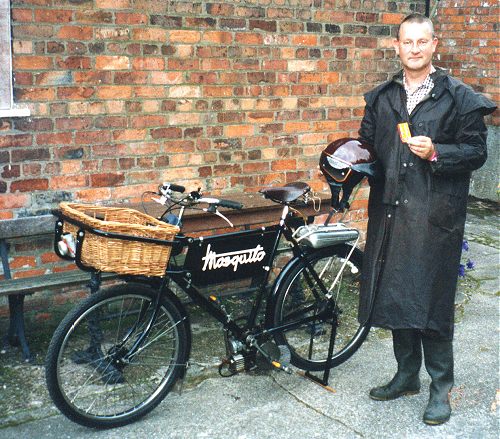
Proud owner!
By 1955 riders were clearly seeking more sophistication. For the next model Garelli retained the same mechanical layout and fixing position, but increased the capacity to 49cc (40mm×39mm) and incorporated a centrifugal clutch. Price by now had increased to £39, and the extra capacity had raised the top speed to 24mph. Fuel consumption had increased to 174 miles a gallon, while the tester commented "only gradients steeper than 1 in 9 called for real physical effort." (In modern terms: "rider prostrate and sweating over crossbar".) The tester also noted that his unit "was fitted to a Mosquito bicycle specially built for use with the engine (though the power unit can be fitted to any suitable pedal cycle)". This was misleading: by the 1950s Garelli were mounting their engine on brackets specially welded to the horizontal fork behind the pedals. Gone was the original removable clamp. In its place a welded fixing for the hanger, and the activation lever for moving the unit off and on the tyre. Moreover, the pedal shank was extended on the left hand side to clear the extended housing which now contained the centrifugal clutch. To be made "suitable" an normal bicycle would need a good deal of welding!
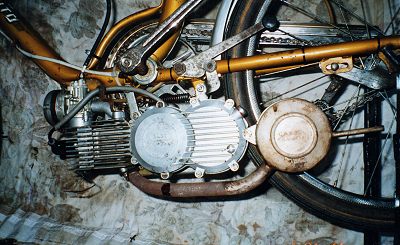
The 35.5cc Baby Mosquito engine
The machine now revelled in the title "Mosquito-Centrimatic". The little clutch is of fascinating design. It has at its centre five caged roller bearings which mount ramps, locking the clutch when the pedals override the engine. This permits the machine to be started in the ordinary way. When the engine reaches reasonably high revs, a rubber ring fixed by a series of indentations to the outer circumference of an internal flywheel expands sufficiently to grip the drum within which it turns, thus transmitting drive. The whole unit runs in oil.
By July 1956 the price had risen to £58-2s-0d including purchase tax and including the specially adapted bicycle. That year's price for a Kreidler 50cc moped was £57-17s-4d including purchase tax. Clearly the Mosquito's days were numbered!
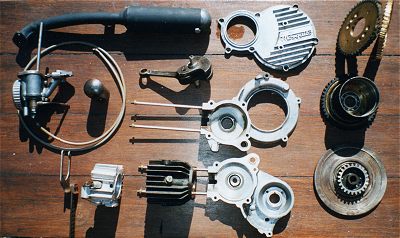
Inside a Mosquito engine
The 1960s saw what I believe to be the final production version of the Mosquito: the Baby Mosquito. Like the Centrimatic, this machine also had a centrifugal clutch, and was mounted on specially fabricated fixings on the bicycle frame. These more rigid (now 4 parallel hangers) fixings permitted the steel strap to the cylinder head to be deleted. A number of interesting changes were made to the Baby Mosquito, including a reduction in capacity to 35.5cc; an alloy rather than cast iron cylinder barrel; and a centrally located, rather than upwardly inclined, spark plug. (Perhaps earlier owners, while changing spark plugs on dark road sides had stripped too many threads from the original angled cylinder heads?) The bicycle itself on the Baby Mosquito, was, appropriately, of smaller design: a shopping bike with one large curved diameter tube for its main frame. Gone, too, was the intermediate fibre drive gear. All gears were now metal. But the mechanical, if not meteorological, climate was changing. UK riders demanded something more positive than friction drive!
Whilst the later designs were no doubt easier to use, to my mind the original lightest and simplest design is the best. It alone can be fitted to any bicycle without modification, and given a dry day can still provide entertaining and effective transport. So let's prove the good Dr Berens completely wrong: let's have far more Mosquitos out in Great Britain!
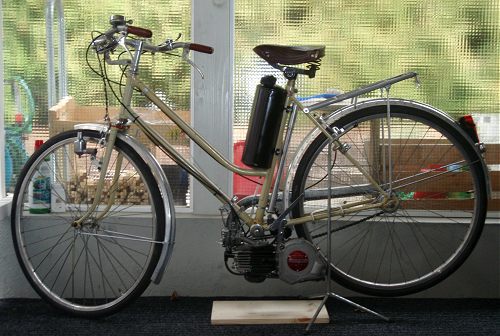
Mosquito 38-B (Photo: Nino Vollenweider)
First published, December 2003